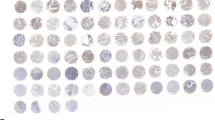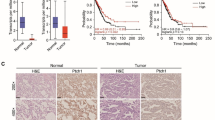Abstract
The molecular mechanism underlying activation of matrix metallopeptidase 9 (MMP9) in non-small cell lung cancer (NSCLC) cells, which controls cancer invasiveness and metastasis, remains elusive. Here, we reported a strong correlation of epidermal growth factor receptor (EGFR) and MMP9 levels in NSCLC patients. Thus, we used a human NSCLC line, A549, to examine whether there is a causal link between EGFR and MMP9 activation. We found that EGF-induced activation of EGFR in A549 cells activated MMP9, resulting in an increase in cancer invasiveness. An EGFR inhibitor efficiently blocked this EGF-induced activation of MMP9 and, consequently, increased cancer invasiveness. Moreover, an inhibitor for phosphatidylinositol 3-kinase (PI3K)/Akt, but not an inhibitor for mitogen-activated protein kinase, or an inhibitor for Jun N-terminal kinase, significantly inhibited the epidermal growth factor (EGF)-induced activation of MMP9, suggesting that PI3K/Akt signaling cascades may be responsible for EGF-activated MMP9. We further dissected the pathway and found that nuclear exclusion of a major Akt downstream target, FoxO1, occurred by EGF-induced Akt activation, which could be inhibited by either EGFR inhibitor or by PI3K/Akt inhibitor. In a loss of function, expression of a constitutive nuclear form of FoxO1 significantly inhibited MMP9 activation induced by EGF. Taken together, these findings suggest that EGF/EGFR signaling activates downstream PI3K/Akt to induce FoxO1 nuclear exclusion, which activates MMP9 to promote NSCLC invasiveness. Thus, Akt and FoxO1, in addition to the well-known EGFR, appear to be promising therapeutic targets for preventing the metastasis of NSCLC.




Similar content being viewed by others
References
Joyce JA, Pollard JW. Microenvironmental regulation of metastasis. Nat Rev Cancer. 2009;9:239–52.
Zarogoulidis K, Zarogoulidis P, Darwiche K, Boutsikou E, Machairiotis N, Tsakiridis K, et al. Treatment of non-small cell lung cancer (nsclc). J Thorac Dis. 2013;5:S389–96.
Mitsudomi T, Suda K, Yatabe Y. Surgery for nsclc in the era of personalized medicine. Nat Rev Clin Oncol. 2013;10:235–44.
Pallis AG, Syrigos KN. Epidermal growth factor receptor tyrosine kinase inhibitors in the treatment of nsclc. Lung Cancer. 2013;80:120–30.
Feng X, Miao G, Han Y, Xu Y. Carma3 is overexpressed in human glioma and promotes cell invasion through mmp9 regulation in a172 cell line. Tumour Biol. 2014;35:149–54.
Yan Y, Liang H, Li T, Li M, Li R, Qin X, et al. The MMP-1, MMP-2, and MMP-9 gene polymorphisms and susceptibility to bladder cancer: a meta-analysis. Tumour Biol. 2014. doi:10.1007/s13277-013-1395-6.
Sun GG, Lu YF, Zhang J, Hu WN. Filamin a regulates MMP-9 expression and suppresses prostate cancer cell migration and invasion. Tumour Biol. 2014. doi:10.1007/s13277-013-1504-6.
Tang ZP, Cui QZ, Dong QZ, Xu K, Wang EH. Ataxia-telangiectasia group d complementing gene (ATDC) upregulates matrix metalloproteinase 9 (MMP-9) to promote lung cancer cell invasion by activating erk and jnk pathways. Tumour Biol. 2013;34:2835–42.
Sutnar A, Pesta M, Liska V, Treska V, Skalicky T, Kormunda S, et al. Clinical relevance of the expression of mrna of MMP-7, MMP-9, TIMP-1, TIMP-2 and CEA tissue samples from colorectal liver metastases. Tumour Biol. 2007;28:247–52.
Schutz A, Schneidenbach D, Aust G, Tannapfel A, Steinert M, Wittekind C. Differential expression and activity status of MMP-1, MMP-2 AND MMP-9 in tumor and stromal cells of squamous cell carcinomas of the lung. Tumour Biol. 2002;23:179–84.
Kim S, Choi JH, Lim HI, Lee SK, Kim WW, Cho S, et al. EGF-induced MMP-9 expression is mediated by the JAK3/ERK pathway, but not by the JAK3/STAT-3 pathway in a SKBR3 breast cancer cell line. Cell Signal. 2009;21:892–8.
Jassem J, Dziadziuszko R. EGFR inhibitors for wild-type EGFR NSCLC: to use or not to use? Lancet Oncol. 2013;14:916–7.
Stella GM, Scabini R, Inghilleri S, Cemmi F, Corso S, Pozzi E, et al. EGFR and KRAS mutational profiling in fresh non-small cell lung cancer (NSCLC) cells. J Cancer Res Clin Oncol. 2013;139:1327–35.
Schneider MR, Wolf E. The epidermal growth factor receptor ligands at a glance. J Cell Physiol. 2009;218:460–6.
Hirsch FR, Janne PA, Eberhardt WE, Cappuzzo F, Thatcher N, Pirker R, et al. Epidermal growth factor receptor inhibition in lung cancer: status 2012. J Thorac Oncol. 2013;8:373–84.
Kobayashi K, Hagiwara K. Epidermal growth factor receptor (EGFR) mutation and personalized therapy in advanced nonsmall cell lung cancer (NSCLC). Target Oncol. 2013;8:27–33.
Sasaki T, Hiroki K, Yamashita Y. The role of epidermal growth factor receptor in cancer metastasis and microenvironment. Biomed Res Int. 2013;2013:546318.
Biggs 3rd WH, Meisenhelder J, Hunter T, Cavenee WK, Arden KC. Protein kinase b/akt-mediated phosphorylation promotes nuclear exclusion of the winged helix transcription factor fkhr1. Proc Natl Acad Sci U S A. 1999;96:7421–6.
Acknowledgments
This work was supported by the internal funding of the Shanghai Chest Hospital, Shanghai Jiao Tong University, China.
Conflicts of interest
None
Author information
Authors and Affiliations
Corresponding author
Additional information
The Publisher and Editor retract this article in accordance with the recommendations of the Committee on Publication Ethics (COPE). After a thorough investigation we have strong reason to believe that the peer review process was compromised.
An erratum to this article can be found online at http://dx.doi.org/10.1007/s13277-017-5487-6.
About this article
Cite this article
Pei, J., Lou, Y., Zhong, R. et al. RETRACTED ARTICLE: MMP9 activation triggered by epidermal growth factor induced FoxO1 nuclear exclusion in non-small cell lung cancer. Tumor Biol. 35, 6673–6678 (2014). https://doi.org/10.1007/s13277-014-1850-z
Received:
Accepted:
Published:
Issue Date:
DOI: https://doi.org/10.1007/s13277-014-1850-z




